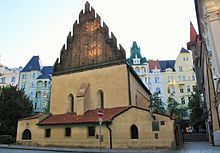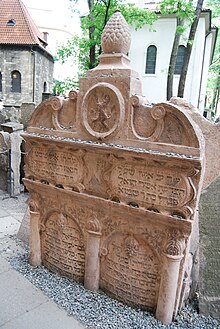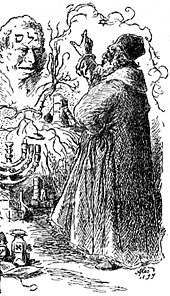Judah Loew ben Bezalel
Rabbi Judah Loew ben Bezalel | |
|---|---|
יהודה ליווא בן בצלאל | |
 | |
| Personal | |
| Born | Between 1512 and 1526 |
| Died | 17 September 1609 (aged 83-97) |
| Religion | Judaism |
| Parent |
|
| Signature |  |
| Buried | Old Jewish Cemetery, Prague |
Judah Loew ben Bezalel(Hebrew:יהודה ליווא בן בצלאל;between 1512 and 1526 – 17 September 1609),[1]also known asRabbi Loew(alt.Löw, Loewe, Löwe or Levai), theMaharal of Prague(Hebrew:מהר״ל מפראג), or simplythe Maharal(theHebrewacronymof "Moreinu ha-Rav Loew",'Our Teacher, Rabbi Loew'), was an importantTalmudicscholar,Jewish mystic,mathematician, astronomer,[2]and philosopher who, for most of his life, served as a leadingrabbiin the cities ofMikulovinMoraviaandPragueinBohemia.
Loew wrote onJewish philosophyandJewish mysticism.His workGur Aryeh al HaTorahis a supercommentary onRashi'sTorahcommentary. He is also the subject of a later legend that he createdthe Golem of Prague,an animate being fashioned from clay.[3]
Name[edit]

His name "Löw" or "Loew" is derived from theGermanLöwe,"lion"(cf. theYiddishLeibof the same origin). It is akinnui,or substitute name, for theHebrewnameJudahorYehuda,as the Biblical characterJudahwas likened to a lion inGenesis 49:9.[4]In Jewish naming tradition, the Hebrew name and the substitute name are often combined as a pair, as in this case in which the combined name is Judah Loew. When Loew wrote his classic supercommentary onRashi'sTorahcommentary, he entitled itGur Aryeh al HaTorahin Hebrew, meaning "Young Lion [commenting] upon the Torah".
Loew's tomb in Prague is decorated with a heraldic shield with a lion with two intertwined tails (queue fourchee), alluding both to his first name and toBohemia,the arms of which has a two-tailed lion.
Biography[edit]
Early life[edit]


Loew was probably born inPoznań,Poland,[5]—though Perels[6]lists the birth town mistakenly[5]asWormsin theHoly Roman Empire—to Rabbi Bezalel (Loew), whose family originated from theRhenish townofWorms.Perels claimed that his grandfather Chajim of Worms was the grandson ofJudah Leib the Elderand thus a claimant to theDavidic line,throughSherira Gaon.[6]However, modern scholars such asOtto Muneleshave challenged this.[7]Loew's birth year is uncertain, with different sources listing 1512,[6]1520[8]and 1526.[5][9]His uncleJakob ben ChajimwasReichsrabbiner( "Rabbi of the Empire" ) of theHoly Roman Empire,and his older brother Chaim of Friedberg was a famous rabbinical scholar and Rabbi of Worms and Friedberg.
Sources in the Lubavitch tradition[10]say that at the age of 12, he went to yeshivahs in Poland and studied under RabbiYaakov Pollak.After Pollak left Poland, he spent 2 years wandering from place to place and then went onto the yeshivah of Rabbi Yitzchak Clover/Wormz, himself a student of Pollak. He learnt together in yeshivah with theMaharshalwho was 17, 2 years his elder. He learnt together with the Maharshal andRemafor 3 years. Rav Yitzchok Clover was in fact the grandfather of the Maharshal. The Maharshal left Poland and the Maharal remained and studied with the Rema for 2 more years. He spent 20 years studying before he married.
It is not known however who he learnt nistar from as he mentions his rabbis, who are unknown to posterity, only once in his sefarim.[11]It was common in yeshivas in Poland however to learn nigleh and nistar together[12]
Career[edit]
He accepted a rabbinical position in 1553 asLandesrabbinerofMoraviaatMikulov(Nikolsburg), directing community affairs but also determining which tractate of theTalmudwas to be studied in the communities in that province. He also revised the community statutes on the election and taxation process. Although he retired from Moravia in 1573 the communities still considered him an authority long after that.
One of his activities in Moravia was the rallying against slanderous slurs on legitimacy (Nadler) that were spread in the community against certain families and could ruin the finding of amarriage partnerfor the children of those families. This phenomenon even affected his own family. He used one of the two yearly grand sermons (betweenRosh HashanahandYom Kippur1583) to denounce the phenomenon.[13]
He moved to Prague in 1573, where he again accepted a rabbinical position, replacing the retired Isaac Hayoth.[13]He immediately reiterated his views onNadler.On 23 February 1592, he had an audience withEmperor Rudolf II,which he attended together with his brother Sinai and his son-in-law Isaac Cohen; Prince Bertier was present with the emperor. The conversation seems to have been related toKabbalah(Jewish mysticism,Hebrew:קַבָּלָה) a subject which held much fascination for the emperor.[13]
In 1592, Loew moved to Poznań, where he had been elected asChief Rabbiof Poland. In Poznań he composedNetivoth Olamand part ofDerech Chaim(see below).[13][14]
Personal life[edit]
His family consisted of his wife, Pearl, six daughters, and a son, Bezalel, who became a rabbi inKolín,but died early in 1600. His wife was the daughter of a wealthy merchant, which allowed him to devote himself to scholarship.[15]
His elder brother wasHayim ben Bezalel,who authored a legal work Vikuach Mayim Chaim which challenged the rulings of Krakow legalist,Moshe Isserles.
Death[edit]
Towards the end of his life he moved back to Prague, where he died in 1609. Loew is buried at theOld Jewish Cemetery, PragueinJosefov,where his grave and tombstone are intact.
Thought[edit]
Loew's numerous philosophical works have become cornerstones of Jewish thought;[16]and he was the author of "one of the most creative and original systems of thought developed by East European Jewry."[15]
He employed rationalist terminology and classical philosophical ideas in his writings,[15]and supported scientific research on condition that it did not contradict divine revelation.[13]Nevertheless, Loew's work was in many ways a reaction to the tradition of medieval rationalist Jewish thought, which prioritized a systematic analysis of philosophical concepts, and implicitly downgraded the more colorful and ad-hoc imagery of earlier rabbinic commentary. One of Loew's constant objectives was to demonstrate how such earlier commentary was in fact full of insightful commentary on humanity, nature, holiness, an other topics. According to Loew, the multitude of disconnected opinions and perspectives in classical rabbinic literature do not form a haphazard jumble, but rather exemplify the diversity of meanings that can be extracted from a single idea or concept.[17]
Loew's writings use as sources the Biblical verses and the recorded traditions of the rabbis, but through literary and conceptual analysis he develops these into a comprehensive philosophical system in which the following terminology recurs:[17]
- sederandnivdal( "order" and "transcendence" ) - any realm has a natural "order" and nature, but may also contain exceptions which are entirely unlike the realm in nature.
- guf, nefesh, sechel( "body", "life-force", "intellect" ) - different levels of a single overall reality.guf(the material) is bounded in dimension and is acted upon.Nefeshis unbounded, and both acts and is acted upon.Sechel "is unbounded, and tends only to be acted upon.
- pail, nifal(active, acted upon) - describing the relationship between different levels of reality
- yesodot, taarovot, tarkovot(bases, mixtures, combinations) - when different elements of reality are combined, they may remain as separate "bases", or else form a relationship (a "mixture" ), or else generate an entirely new entity ( "combinations" ).
- ribui, ahadut(multiplicity, unity)
An example of this terminology is Loew's philosophical interpretation of the followingmidrash:"The world was created for three things:challah,maaser,andbikkurim."[18]According to Loew, bikkurim representsyesodot(as individual fruit are given), maaser representstaarovot(as the fruit are gathered together and a fraction of them separated as a tithe), andchallahrepresentstarkovot(as a new substance, dough, is created from the ingredients).[19]
Loew's worldview assumes that reality consists of a single cause, as well as diverse caused phenomena whose existence is constantly sustained by their cause. There is no room for randomness in reality, as that would indicated an absence of omnipotence or omniscience in the Cause.[17]For Loew, the uniform caused nature of reality also indicates the existence of moral order in the world. Science can describe the phenomena in the world, but it cannot create a preference for one over the other; such moral preferences must come from the higher order of the Torah, which Loew calls the "higher intellect" (שכן עליון).[17]
Loew emphasized the value of honesty and straightforwardness. Among other things, this led him to criticize thepilpulmethodology common in yeshivas of his time. He even suggested to avoid learning the commentaries ofTosafotuntil one has reached an advanced level of understanding.[17]
LikeYehudah Halevi,he focused on the distinction between the physical and the spiritual, seeing the Jewish people as possessing an essentially spiritual nature which distinguishes it from all other phenomena in the world.[15]
Lowe did not espousekabbalahor other Jewish mystical traditions, though he was familiar with them.[15]
Influence[edit]
Disciples[edit]
It is unknown how many Talmudic rabbinical scholars Loew taught in Moravia, but the main disciples from the Prague period include RabbisYom-Tov Lipmann HellerandDavid Gans.The former promoted his teacher's program of regularMishnahstudy by the masses, and composed hisTosefoth Yom Tov(a Mishnah commentary incorporated into almost all published editions of the Mishnah over the past few hundred years) with this goal in mind.David GanzwroteTzemach David,a work of Jewish and general history, as well as writing onastronomy;both Loew and Ganz were in contact withTycho Brahe,the famous astronomer.
Commemoration[edit]
Kerem Maharal,a moshav in northern Israel, was established by Czech Jewish immigrants and named in his honour.
In April 1997, Czech Republic and Israel jointly issued a set of stamps, one of which featured the tombstone of Loew.[20][21][22]In May 2009, the Czech Post issued a stamp commemorating the 400th anniversary of Loew's death.[23]In June 2009 the Czech Mint issued acommemorative coinmarking the same milestone.[24]TheStatue of Judah Loew ben Bezalelstands in Prague.

Legend of the golem[edit]
Loew is the subject of the legend about the creation of agolem,a creature made out of clay to defend theJewsof the PragueGhettofromantisemiticattacks, particularly theblood libel.He is said to have usedmystical powersbased on theesotericknowledge of howGodcreatedAdam.[25]The general view of historians and critics is that the legend is a German literary invention of the early 19th century. The earliest known source for the story thus far is the 1834 bookDer Jüdische Gil Blasby Friedrich Korn.[26][27]It has been repeated and adapted many times since.
Works[edit]

He began publishing his books at a very late age. In 1578, at the age of 66, he published his first book,Gur Aryeh( "Young Lion", Prague 1578) - an supercommentary in five volumes forRashi's commentary on theTorah,which goes well beyond that, and four years later he published his bookGevuroth HaShem( "God's Might[y Acts]", Cracow 1582) anonymously.
- Gur Aryeh( "Young Lion", Prague 1578), a supercommentary on Rashi's Pentateuch commentary
- Gevuroth Hashem( "God's Mighty Acts", Cracow 1582), for the holiday ofPassover- Onthe Exodusand the Miracles.
- Derech Chaim( "Way of Life", Cracow 1589), a commentary on theMishnahtractateAvoth
- Derashot( "Sermons", Prague 1589 and 1593), collected edition by Haim Pardes, Tel Aviv 1996.
- Netivoth Olam( "Pathways of the World", Prague 1595-1596), a work of ethics
- Be'er ha-Golah( "The Well of Exile", Prague 1598), an explanatory work on the Talmudic and MidrashicAggadah,mainly responding to interpretations by the Italian scholarAzariah dei Rossi(Azariah min ha-Adumim)
- Netzach Yisrael( "The Eternity of Israel", Prague 1599;Netzach"eternity", has the same root as the word for victory), onTisha B'Av(an annual day of mourning about the destruction of the Temples and the Jewish exile) and the final deliverance
- Tif'ereth Yisrael( "The Glory of Israel", Venice 1599), philosophical exposition on the Torah, intended for the holiday ofShavuot
- Or Chadash( "A New Light", Prague 1600), onPurim
- Ner Mitzvah( "The Candle of the Commandment", Prague 1600), onHanukkah
- Chiddushei Aggadot( "Novellaeon theAggada",the narrative portions of the Talmud), discovered in the 20th century
- Divrei Negidim( "Words of Rectors" ), a commentary on theSederofPesach,published by a descendant
- Chiddushim al Ha-Shas,a commentary on Talmud, recently published for the first time from a manuscript by Machon Yerushalayim on Bava Metzia; Shabbos, and Eruvin; others may be forthcoming.
- Various other works, such as hisresponsaand works on theJewish Sabbathand the holidays ofSukkot,Rosh HashanaandYom Kippur,have not been preserved.
His works on the holidays bear titles that were inspired by the Biblical verse inI Chronicles29:11: "Yours, O Lord, are the greatness, and the might, and the glory, and the victory, and the majesty, for all that is in the heavens and on the earth [is Yours]; Yours is the kingdom and [You are He] Who is exalted over everything as the Leader." The book of "greatness" (gedula) on the Sabbath was not preserved, but the book of "power" (gevurah) isGevurath Hashem,the book of glory (tif'arah) isTif'ereth Yisrael,and the book of "eternity" or "victory" (netzach) isNetzach Yisrael.
References[edit]
- ^Bohemia, as a Catholic country, adopted theGregorian calendarin 1584. On the Julian calendar it was 7 September. His gravestone, as quoted by Gal Ed, Megilas Yuchsin and others, gives his date of death as Thursday, 18 Elul 5369.
- ^Solomon Grayzel,A History of the Jews,The Jewish Publication Society of America,Philadelphia, 1968, pp. 484-485: "Another important personality in Prague... was Rabbi Judah-Loew ben Bezalel. Besides being a great Talmudist, he was a mathematician and astronomer.
- ^Solomon Grayzel,A History of the Jews,The Jewish Publication Society of America,Philadelphia, 1968, p. 485: "after the rabbi's death (1609), numerous legends began to develop about him. The most famous one was the story of the giant body (golam) which he had fashioned out of earth. "
- ^SeeLion of Judah
- ^abcד "ר א. הכהן עובדיה Dr Avraham Hacohen Ovadia (Gotsdiner) (2001).Ha'ari Shebechachmai Prague(in Hebrew).Jerusalem,Israel:Mosad Harav Kook.p. 138.OCLC145439809.Archived fromthe originalon 2009-05-29.
- ^abcMeir Perels (1718).Megilas Yuchsin.Prague.OCLC122864700.
- ^Muneles, Otto (1955).Der Alte jüdische Friedhof in Prag.
- ^Nathan Grün (1885).Der hohe Rabbi Löw und sein Sagenkreis(in German).Prague:Verlag von Jakob B. Brandeis.OCLC19037024.
- ^Luboš Jeřábek (1903).Der alte Prager Judenfriedhof(in German).Prague:Kunstverlag B. Koci.OCLC1810845.
- ^Schneerson, Yosef Yitzchok (1960)."Memoirs of the Lubavitcher Rabbi".
- ^Shabbos hagodol drosha.
- ^Schneerson, Rabbi Yosef Yitzchok.Memoirs of the lubavitcher rabbi.
- ^abcde
 This article incorporates text from a publication now in thepublic domain:Singer, Isidore;et al., eds. (1901–1906)."JUDAH LÖW (LÖB, LIWA) BEN BEZALEEL (known also as Der Hohe Rabbi Löw)".The Jewish Encyclopedia.New York: Funk & Wagnalls.
This article incorporates text from a publication now in thepublic domain:Singer, Isidore;et al., eds. (1901–1906)."JUDAH LÖW (LÖB, LIWA) BEN BEZALEEL (known also as Der Hohe Rabbi Löw)".The Jewish Encyclopedia.New York: Funk & Wagnalls.
- ^"Sefer Detail: וכוח מים חיים -- חיים בן בצלאל".hebrewbooks.org.RetrievedApr 2,2023.
- ^abcdeYIVO Encyclopedia - Yehudah Leib ben Betsalel.
- ^sefaria.org,Maharal (1520 - 1609 CE)
- ^abcde"המהר" ל מפראג ".RetrievedApr 2,2023.
- ^Genesis Rabbah1:4
- ^Netzach Yisrael 3
- ^"1997 Prague Jewish Monuments - Czech Joint Issue".Archived fromthe originalon 2016-03-03.Retrieved2009-09-30.
- ^Jewish Monuments in Prague Joint IsuueArchived2011-07-21 at theWayback Machine,israelphilately.org.il
- ^"Israel '98 World Stamp Exhibition".engaging.net.
- ^Rabbi Judah Loew,Česká pošta
- ^"2009 Czech 200Kr Silver Proof" Judah Loew "".RetrievedApr 2,2023.[permanent dead link]
- ^Bilefsky, Dan(May 11, 2009)."Hard Times Give New Life to Prague's Golem".New York Times.Retrieved2009-05-11.
- ^Freimann-Sammlung / Der jüdische Gil Blas.1834.
{{cite book}}:|website=ignored (help) - ^Kohn, J. S.,Der jüdische Gil Blas,Leipzig, 1834, p.20
Further reading[edit]
- Byron L. Sherwin,Mystical Theology and Social Dissent: The Life and Works of Judah Loew of Prague(Fairleigh Dickinson University Press, 1982)
- Rivka Schatz Uffenheimer,"Maharal's Conception of Law- Antithesis to Natural Law"Jewish Law AnnualVol. VI.
- Rivka Schatz Uffenheimer,"Existence and Eschatology in the Teachings of the Maharal" Immanuel 14 (Spring 1982) 66–97; Immanuel 15 (Winter 1982-3) 62–72.
- Moshe Zuriel "Numbers: Their meaning and Symbolism According to Maharal" [Hebrew] HaMaayan 18:3 (1978) 14–23; 18:4 (1978) 30–41, reprinted in Sefer Ozrot Gedolei Yisroel (Jerusalem:2000) volume 1, pp. 204–228.
- Martin Buber, "The Beginning of the National Idea"On Zion: The History of an Idea.(New York, Schocken Books, 1973).
- Otto Dov Kulka, "The Historical Background of the National and Educational Teachings of the Maharal of Prague" [Hebrew]Zion50 (1985) 277–320.
- Benjamin Gross,Netzah Yisrael(Tel Aviv: Devir, 1974)
- Mordechai Breuer, "The Maharal of Prague's Disputation with Christians: A Reappraisal of Be'er Ha-Golah" inTarbiẕ(1986) 253-260
- Adlerstein Y.Be'er Hagolah: The Classic Defense of Rabbinic Judaism Through the Profundity of the Aggadah.New York, NY: Mesorah Publications, 2000.ISBN1-57819-463-6.
- Aharon Kleinberger,The Educational Theory of the Maharal of Prague[Hebrew] (Magnes: 1962).
- Andre Neher,Jewish Thought and the Scientific Revolution: David Gans (1541–1613) and his times(Oxford-New York: Littman Library, 1986)
- Neher,Faust et le Maharal de Prague: le Mythe et le Reel(Paris: Presses Universitaires de France, 1987);
- Neher,Le Puits de l'Exil: la Theologie Dialectique du Maharal de Prague(Paris: A. Michel, 1996)
- Neher,Mishnato shel ha-Maharal mi-Prague,Reʾuven Mass, c2003.
- Gross, Benjamin,Yehi Or(Reʾuven Mass, 1995).
- Gross, Benjamin,Netsah YiśraʾelTel Aviv: Devir, 1974.
- Eliyahu Yaakov Deutsch,Shabbos Insights Of The MaharalJerusalem: Targum, 2009.
- Shulman, Yaacov Dovid(1992).The Maharal of Prague: the story of Rabbi Yehudah Loew.New York: CIS.ISBN1-56062-168-0.OCLC27887477.
External links[edit]
- YIVO Encyclopedia - Yehudah Leib ben Betsalel
- Gregor Brand (2008). "Löw, Juda (Yehuda, Jehudah, Yudah, Judah) ben Bezalel (auch Löwe, Löb, Livia, Liwa etc., Akronym:" MaHaRaL ")". In Bautz, Traugott (ed.).Biographisch-Bibliographisches Kirchenlexikon (BBKL)(in German). Vol. 29. Nordhausen: Bautz. cols. 858–877.ISBN978-3-88309-452-6.
- Yehuda Loew — The Maharaljewishvirtuallibrary.org
- Family tree
- Shiurim on Derech Chaim at Torah.org
Resources[edit]
- Tiferet Yisrael,Hebrew full text
- 1609 deaths
- 16th-century Polish astronomers
- 16th-century Polish philosophers
- 16th-century Polish rabbis
- 16th-century births
- 16th-century rabbis from Bohemia
- 17th-century Polish rabbis
- Clergy from Poznań
- Czech Orthodox rabbis
- Czech folklore
- Czech people of Polish-Jewish descent
- Davidic line
- Exponents of Jewish law
- Golem
- Jewish folklore
- Medieval Jewish philosophers
- Kabbalists
- Medieval occultists
- Philosophers of Judaism
- Rabbis from Nikolsburg
- Rabbis of Prague
